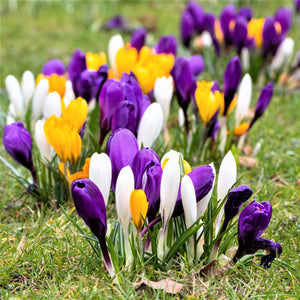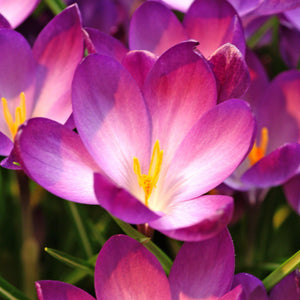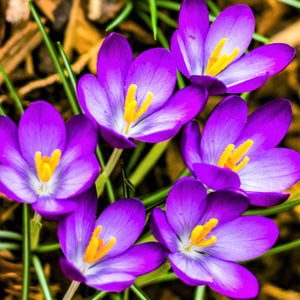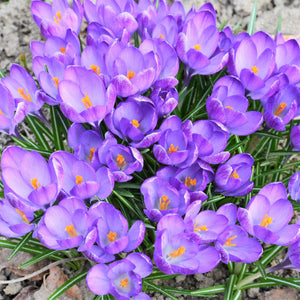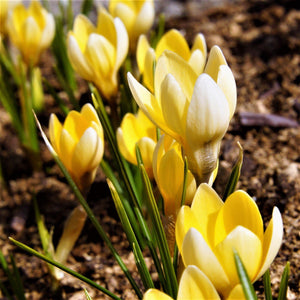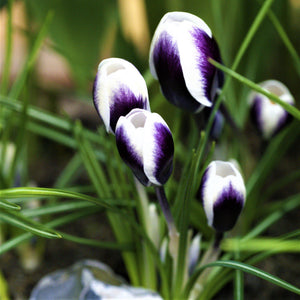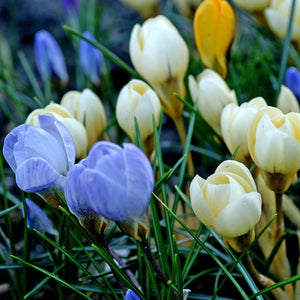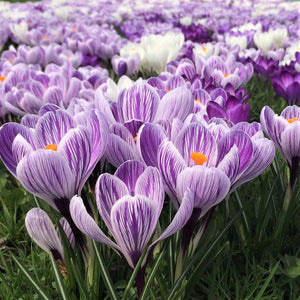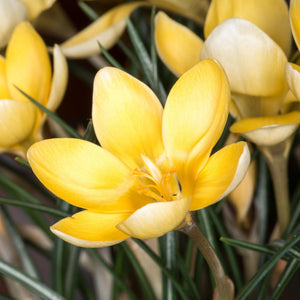- Home
- Planting Guides
- Saffron Crocus Planting & Growing Guide
Saffron Crocus Planting & Growing Guide
Grow one of the world's most expensive and sought-after spices right in your own garden with Crocus Sativus! Not to mention, these plants yield gorgeous, creamy lilac flowers with dark purple veining and red stamens that contrast beautifully against the bold orange anthers. The blossoms are ideal for naturalizing and look stunning in vast, sweeping masses. The dried stamen, known as Saffron, is a deep red spice often used in ethnic cuisines. This spice can be expensive in stores, but you can "harvest" your own in less than a minute! Here's everything you need to know.
Success Snapshot
PLANTING
DEPTH
3-4"

WATER
QUANTITY
Moderate; Low in dormancy
SUNLIGHT
QUANTITY
Full Sun
PLANTING
PROXIMITY
2-3" Apart
BLOOM
SEASON
Late Fall. Other crocus in Late Winter/Early Spring
HARDINESS
ZONES
Zones 6-9. Other crocus Zones 3-8
Shop Related Products

Crocus - Large Flowering Mix
$39.95
Contains: 60 Crocus bulbs mixed
Botanical Name: Crocus
Exposure: Full Sun
Hardiness: Zones 3-8

Crocus - Ruby Giant (Fragrant)
$6.95
Contains: 20 Crocus bulbs
Botanical Name: Crocus tommasinianus 'Ruby Giant'
Exposure: Full Sun
Hardiness: Zones 3-8

Crocus - Flower Record
$19.95
Contains: 20 Crocus bulbs
Botanical Name: Crocus vernus 'Flower Record'
Exposure: Full Sun
Hardiness: Zones 3-8

Crocus - Saffron
$19.95
Contains: Saffron Crocus bulbs
Botanical Name: Crocus sativus
Exposure: Full Sun
Hardiness: Zones 6-9

Crocus - Cream Beauty (Fragrant)
$8.95
Contains: 20 Crocus bulbs
Botanical Name: Crocus chrysanthus 'Cream Beauty'
Exposure: Full Sun
Hardiness: Zones 3-8

Crocus - Prins Claus
$10.95
Contains: 20 Crocus bulbs
Botanical Name: Crocus chrysanthus 'Prins Claus'
Exposure: Full Sun
Hardiness: Zones 3-8

Crocus - Chrysanthus Mix
$24.95
Contains: 60 Crocus bulbs mixed
Botanical Name: Crocus chrysanthus
Exposure: Full Sun
Hardiness: Zones 3-8

Crocus - King of the Striped
$10.95
Contains: 20 Crocus bulbs
Botanical Name: Crocus vernus 'King of the Stripes'
Exposure: Full Sun
Hardiness: Zones 3 - 8

Crocus - Goldilocks
$4.95
Contains: 20 Crocus bulbs
Botanical Name: Crocus chrysanthus 'Goldilocks'
Exposure: Full Sun
Hardiness: Zones 3-8
Where to Plant
Whether you're planting in containers or garden beds, Crocuses perform best in locations where the soil drains well, and they will receive full-day sun or very light shade. They're not very fussy, but they will not thrive in waterlogged soil, so if you notice water puddles 5–6 hours after a hard rain, scout out another site or amend the soil with organic material. Saffron Crocuses fancy average amounts of moisture in the spring but prefer dry sites in the summer when they are dormant. If your region experiences wet summers, plant under the eaves for summer dryness, providing supplemental moisture in the spring. Remember: you can always move your containers seasonally to meet their needs!
When to Plant
Plant your Crocus bulbs before the ground freezes in the fall, around September or October in most areas. The roots will begin to form shortly after planting, and in warm regions, some foliage may also develop in the fall. You can expect buds and flowers to be produced from late summer to fall.
How to Plant
- For container planting, find a large container with adequate drainage holes and fill it with good quality, well-draining soil. Almost any commercially available potting mix will do the trick.
- Site your Crocuses where they will receive full-day sun to partial shade.
- Dig holes and plant the bulbs 3-4“ deep and 2-3" apart, with the pointed end facing up.
- Water thoroughly after planting to soak the soil and settle it around the bulbs.
How to Grow
- Water as needed during active growth periods without waterlogging the soil. About 1" of water per week is a reasonable estimate.
- Leave the foliage in place at the end of the blooming season rather than trim it off. The leaves will gather sunlight to create food through photosynthesis, strengthening the bulbs for the future.
- Remove the foliage when the leaves turn yellow and die back as the plant slips into dormancy.
- Withhold water when the leaves are absent, and the bulbs are dormant.
Saffron Crocus Tips & Tricks
- Amend soil with organic material to raise the level 2-3" and improve drainage. Compost, ground bark, or composted manure all work a charm and are widely available.
- Plant bulbs on their sides if you're having trouble discerning which side should face up. Don't worry - the root action will direct the bulbs into the correct position.
- Don't worry if your bulbs don't flower the first season, as they'll reliably bloom the following fall.
- Feel free to trim the brilliant stamens while in bloom for delicious recipes or dry them for later use.
- Bear in mind that the foliage may stay green until mid-spring in warmer regions before turning yellow and dying back.
- Overwinter your containers in an unheated garage to help mitigate the effects of the big temperature swings that can come with sunny winter days and bitter nights.
- Don't forget - Saffron Crocuses are fall bloomers who sprout spring foliage.

